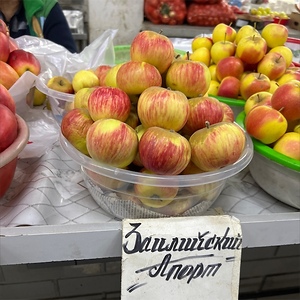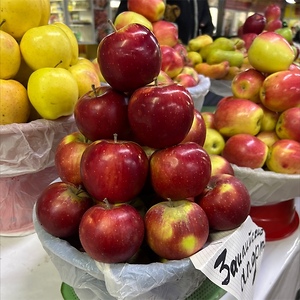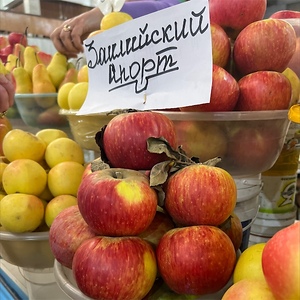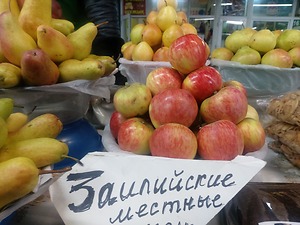


Ile Alatau Aport Apples
Estimated Inventory, lb : 0
Description/Taste
Ile Alatau Aport apples are moderately-sized, round to oblate fruits, with a slightly flattened, irregular appearance. The skin is smooth, waxy, and covered in a dull bloom, bearing a small patch of brown russet around the stem. The fruit also has a green-yellow base with variegated red striping and blush. Underneath the thin skin, the flesh is pale yellow-green, soft, crisp, and aqueous, encasing a central core filled with a few small, brown-black seeds. Ile Alatau Aport apples are juicy and aromatic with a sweet and sour flavor.
Seasons/Availability
Ile Alatau Aport apples are harvested in the late fall through early winter and can be stored until the spring.
Current Facts
Ile Alatau Aport apples, botanically classified as Malus domestica, are a late autumn variety that belongs to the Rosaceae family. Also known as Zailiyskiy apples, Ile Alatau Aport apples were developed from a cross between reinette burchardt and Alexandrian aport apples at the Kazakh Research Institute of Fruit Growing and Viticulture in Kazakhstan. The apples are locally grown and favored for their sweet-tart flavor, primarily consumed fresh as a dessert variety. Ile Alatau Aport apple trees have also become a popular home garden variety for their compact nature, frost tolerance, and resistance to some diseases. Outside of Kazakhstan, the variety has seen an increase in growth among home gardens in Voronezh, which is a city in southwestern Russia. This increase in cultivation is primarily credited to Yu. V. Kositsyn, who imported a wide selection of fruits from Kazakhstan into Russia to expand the home gardening market.
Nutritional Value
Ile Alatau Aport apples are an excellent source of antioxidants such as vitamin C, which can help boost the immune system and is a good source of fiber, which can help regulate digestion. The apples also contain some potassium, vitamin B6, manganese, riboflavin, and vitamin K.
Applications
Ile Alatau Aport apples are best suited for raw applications as their sweet and sour flavor is showcased when consumed fresh, out-of-hand. The flesh can be sliced and eaten as a snack, chopped and added to fruit and green salads, or quartered and displayed on appetizer plates with cheeses, nuts, and dried fruits. Ile Alatau Aport apples can also be cooked into sauces, compotes, and preserves, cooked and served with roasted meats, tossed into rice, or baked into muffins, bread, cakes, pies, and tarts. Ile Alatau Aport apples pair well with spices such as nutmeg, cinnamon, and cloves, raisins, dried apricots, nuts such as walnuts, pistachios, and almonds, and cheeses such as cheddar, bleu, and sheep’s milk. The fresh apples will keep 1-4 months when stored in a cool, dry, and dark place.
Ethnic/Cultural Info
In Almaty, Kazakhstan, apples are a source of national pride and have become the symbol of the city. Despite the fruit’s major presence at local markets and festivals, much of the wild apple forests located near the city have been destroyed due to past urban development and deforestation. To save the remaining forests, protected areas have been established, such as the Ile-Alatau National Park, which spans over seven hundred miles within the Tian Shan mountain range. The protected land serves to maintain and preserve the history of the wild apple cultivar while also educating the visitors on the importance of the region. Visitors can tour the protected areas on guide-led expeditions and learn about the wild apple trees that remain.
Geography/History
Ile Alatau Aport apples were created at the Kazakh Research Institute of Fruit Growing and Viticulture in Kazakhstan. While the exact date of when the variety was developed is unknown, Ile Alatau Aport apples are believed to be a natural cross between reinette burchardt and Alexandrian aport apples. Today Ile Alatau Aport apples are primarily available through local markets and small farms in Kazakhstan. The apples are also grown in neighboring countries throughout Central Asia, in Eastern European countries such as Latvia, and in Southern Russia.














